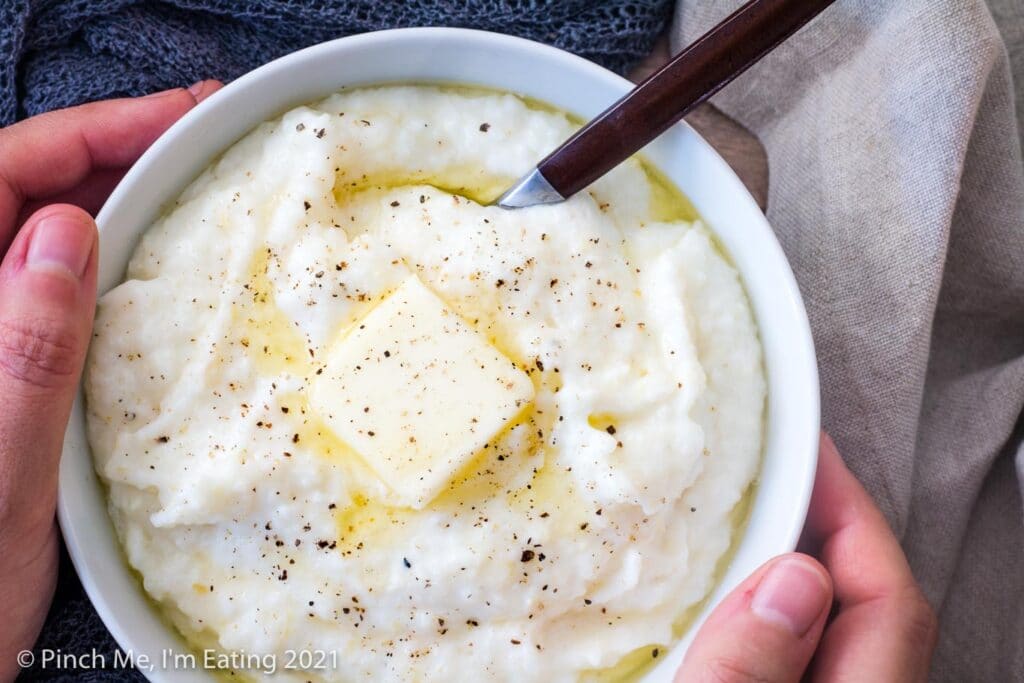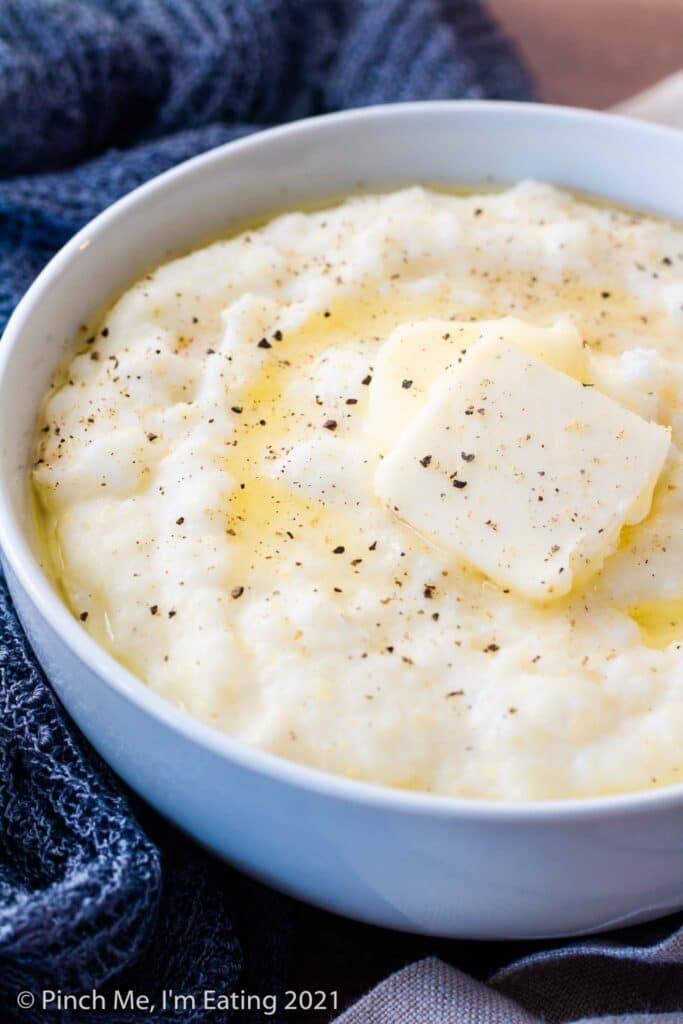Learn how to make creamy Southern grits — these are rich, super thick, never runny, and melt in your mouth! They’re perfect as a base for shrimp and grits, with cheese melted in, or just topped with a little salt and pepper.
This post may contain affiliate links. That means if you click on the link and make a purchase, I will receive an affiliate commission at no extra cost to you. All opinions remain my own. As an Amazon associate, I earn from qualifying purchases.
If you want to make Southern food (especially brunch!), it’s essential to know how to make a good, creamy pot of grits. These grits never turn out runny, are packed with flavor, and melt in your mouth! Perfect as a base for shrimp and grits or with a heaping serving of pimento cheese stirred in.
If you’re from the Southeastern United States, this question needs no answer. However, if you’re not from ’round these here parts, you may need a little primer.
Simply put, grits are a porridge made from cooking ground corn in liquid. They’re a staple food in the South, typically eaten for breakfast or brunch, but also not out of place at the dinner table. While similar to Italian polenta, which is made from finely ground corn or cornmeal, grits are typically made with a slightly coarser grind.
Grits can be made from a medium grind (like Quaker old-fashioned grits) or coarser, like stone-ground grits, which add a lot of nice toothy texture. If you want seriously smooth and creamy grits, though, I’d recommend using Quaker old-fashioned grits rather than stone-ground.
While you can make grits from just the ground corn and water, for truly rich and creamy grits, we’re going to use a mixture of water, milk, cream, and butter to cook them in. Plus a little extra cream for good measure.
if you want a pure grit flavor, go with a ratio of 1 cup grits to 4 cups water, and a healthy pinch of salt. bring your water to a boil, whisk in the salt, then whisk in your grits to prevent clumping. cook at least 45 minutes to an hour on a poppingly low flame. if you scorch the bottom your grits are no good.

About the creamiest ever grits
When I was in elementary school I was the youngest person, by decades, in several demonstration-only cooking classes at a place called Charleston Cooks (which sadly, closed a couple years ago). Just imagine nine-year-old me, surrounded by a classroom full of middle-aged women, listening attentively and taking notes on the recipe printouts the instructors gave us as they showed us how to cook delicious dishes at the front of the room.
I can’t tell you how excited I was when one of my cooking classes featured none other than the chef from The Old Post Office restaurant on Edisto Island.

For several summers, my family (complete with aunts, uncles, cousins, and grandmother) had spent a week at a beach house at Edisto Island, and dining at The Old Post Office was a much-anticipated treat during our stay. I was intimately familiar with their shrimp and grits, which were the best I had ever tasted. I had never tasted grits so rich and creamy. They just utterly melted in your mouth.
So when their chef was teaching one of the cooking classes I attended, you can imagine my excitement. And he told us the secret to their mouthwateringly creamy grits.
Y’all, it makes you want to have a heart attack just listening to it. But it’s soooo good.
Now, let me add a disclaimer to this. I could be wrong, since I am recalling this from 25 years ago. But this is what I remember him telling us.
He cooked his grits all day in a big pot. And he cooked it with equal parts water, milk, cream, and butter. And when it was all soaked up? He added more water. Milk. Cream. And butter. Just like a risotto.
I mean, no WONDER it was so good.

So whenever I’ve made grits throughout my life, I’ve kept his secret in mind. Now, I don’t make mine quite as rich as he did. Something that decadent would be saved for a once-a-year special occasion. But I do cook my grits in water, milk, cream, and butter — just not an equal ratio. And they do come out oh-so-creamy and delicious.
A note on that ratio: I would even suggest going for a 6:1 liquid to grits. Grits, like polenta, will set up as they cool, and unless youre stirring in a cup of cream at the end (which is not a bad idea) its a good plan to err on the side of more liquid. Remember, butter isnt a “wet” ingredient, so when you stir it in itll stiffen as it cools.
Turns out, I didnt have it. Maybe the grits themselves could sense my fear. Maybe they knew that I was stepping into unfamiliar territory since I never really had them growing up. The final product wasnt awful, per se, but they were 90% smooth and creamy and 10% kind of crunchy. It was a texture I can only describe as “weird.” They looked really nice and beautiful, except for some too-frequent coarse pieces that felt like hard flakes. It was one of those meals that I could swallow down by myself but was glad I wasnt serving the grits to anyone else.
I think you were really just 10 minutes away from grit greatness. Sometimes the real prize is just takes a little extra patience.
I really think thats all that went wrong for you, SMACNSC. It sounds like you started off on the right track. Im assuming you used at least a 5:1 liquid-to-grits ratio. You did, right? Then you BTAB (“Brought To A Boil” in restaurant short hand), whisked, reduced heat, whisked, whisked, whisked, whisked…whisked. Excellent technique! But if youre using high quality grits—we love Anson Mills, duh—youre going to find bits of uneven texture, and thats a good thing. Even after an hour there will be some larger pieces that still need more time. The small bits wont suffer from a longer simmer. See, grits wont get mushy like grains—theyll just get creamier. So just do what you did. Keep the party going on low heat and keep on whisking. I remember learning to tell when polenta was ready, and I use this same method with grits: Take a tiny bite and push the grains through closed teeth with your tongue. They should yield. If they dont? Keep it going.
I admire the time and care you took to prepare for your grits-ploration. So often we jump in thinking “Im just gonna wing it!” only to realize that we have no business rolling our own sushi or fermenting our own sauerkraut. But no matter how well we prepare, theres one thing no amount of research can buy: patience.
How to make the BEST cheese grits !
FAQ
Are grits better with milk or water?
What makes grits better?
Why are my grits not creamy?
Which grits are best?
While instant or quick-cooking grits are a good alternative if you’re on the go, authentic Southern recipes use old-fashioned or hominy style grits. Quaker Old Fashioned Grits ($2; walmart.com) is probably the easiest brand to find, but we also love Anson Mills Grits for a delicious corny flavor and coarse texture.
What nutritional value does grits have?
One quarter cup (41 grams) of cooked, regular grits contains 182 calories, 4 grams of protein, and 1 gram of fat. They are also a good source of fiber, which can help to regulate digestion, reducing blood cholesterol levels, and the risk of heart failure.
Are quick grits healthy?
The finer grind on quick grits is what makes the cooking time quicker. They usually cook for around 5 to 10 minutes. These are what we mainly eat, but quick grits are not as healthy as stone ground grits. The last type of grits we will talk about is instant grits. Instant grits are pre-cooked and then dehydrated.
What do people eat grits for?
While they are typically breakfast food, many people also eat them for supper (dinner). In addition, people also serve them as a Shrimp and Grits entree dish, which originated in South Carolina. Another way they are served is by allowing the grits to get cold, then they can be fried and served as a side dish.
